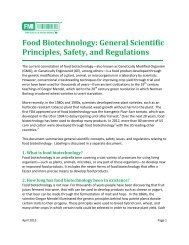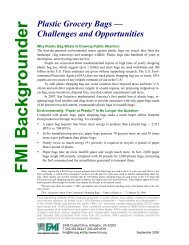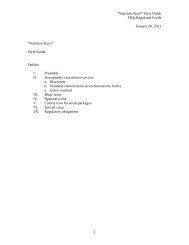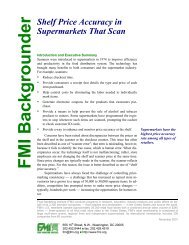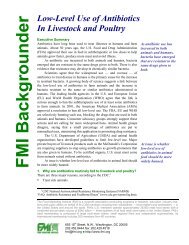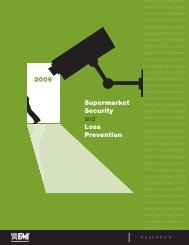Consumer Shopping Habits for Wellness and Environmentally ...
Consumer Shopping Habits for Wellness and Environmentally ...
Consumer Shopping Habits for Wellness and Environmentally ...
You also want an ePaper? Increase the reach of your titles
YUMPU automatically turns print PDFs into web optimized ePapers that Google loves.
In total, we spoke with 33 consumers through two <strong>for</strong>mats, those being combined In-Home <strong>and</strong><br />
Shop-<strong>and</strong>-Talk Interviews, <strong>and</strong> Ethnographic Research Groups, both of which are detailed below.<br />
IN-HOME INTERVIEWS AND SHOP AND TALK TOURS (15 PARTICIPANTS)<br />
There are many things that people seldom talk about (at least not openly), or that only manifest<br />
themselves after intense discussion, particularly matters of habit that are rarely reflected upon. For<br />
this reason, we carry out in-depth interviews in consumers‘ homes where a trained ethnographer<br />
talks with a consumer in detail using a discussion guide. The interviewer gives the participant enough<br />
space to express his/her opinions <strong>and</strong> leads the discussion flexibly along pre-structured topics <strong>and</strong><br />
by asking targeted follow-up questions <strong>and</strong> probes. Mutual trust between the interviewer <strong>and</strong> the<br />
participant develops, which enables them to talk openly about difficult questions or ―hard to<br />
remember‖ events <strong>and</strong> circumstances be<strong>for</strong>e proceeding to more targeted engagement techniques.<br />
As part of these interviews, we conduct ―house tours‖ to explore pantries, medicine cabinets, etc.<br />
These explorations help us to identify the common disconnect between what people say they do or<br />
aspire to <strong>and</strong> what they actually do with respect to Health <strong>and</strong> <strong>Wellness</strong>. For example, we often meet<br />
consumers who tell us they buy ―lots of organic‖ however, upon inspection of their pantry, we may<br />
find few organic products.<br />
Following In-Home Interviews, we accompanied consumers on Shop <strong>and</strong> Talk tours of relevant<br />
retailers. These are anthropological on-site interviews undertaken within retailers wherein we ―tag<br />
along,‖ as unobtrusively as possible <strong>and</strong> interview the consumer as s/he shops. We rely on this<br />
technique as a means of exploring consumer retail experiences; to see a store through their eyes. In<br />
this case we paid particular attention health <strong>and</strong> wellness cues <strong>and</strong> markers where they are present<br />
in general merch<strong>and</strong>ise, health, beauty <strong>and</strong> wellness categories, <strong>and</strong> just as importantly, where they<br />
are absent. Unlike store intercepts, this method permits us to underst<strong>and</strong> the retail experience from<br />
entrance to exit within the context (established during the in-home interview) of the consumer‘s H+W<br />
lifestyle.<br />
ETHNOGRAPHIC RESEARCH GROUPS (3 GROUPS OF 6 CONSUMERS = 18 PARTICIPANTS)<br />
In these Groups, consumers gather at a ―neutral‖ location such as a coffee house, restaurant or loft<br />
space <strong>and</strong> are guided by a Hartman Group researcher through a conversation centered on their<br />
involvement with H+W. Some of the participating consumers may know one another, but there are<br />
also unknown individuals in the group, providing <strong>for</strong> an interview that is com<strong>for</strong>table yet not subject to<br />
the social dynamics of a close group of friends. Unlike focus groups, consumers at these groups are<br />
relatively unencumbered by self-presentation bias.<br />
PARTICIPANT SCREENING<br />
The 33 qualitative participants <strong>for</strong> this study were screened <strong>for</strong><br />
Representation across all three Health <strong>and</strong> <strong>Wellness</strong> segments (Periphery, Mid-level,<br />
Core), with the most (~60%) recruited from the Mid-level, some from Periphery (~25%),<br />
<strong>and</strong> the smallest group from the (~15%) from the Core<br />
Age (22-59)<br />
Diversity across race/ethnicity, age, gender (but no more than 25% male)<br />
<strong>Shopping</strong> patterns including specific retailers of interest<br />
Mix of household incomes $40k+<br />
10




